- Home
- Carl Sagan
Shadows of Forgotten Ancestors Page 12
Shadows of Forgotten Ancestors Read online
Page 12
Early enzymes had to be discriminating; they had to take care not to decompose the very similar molecules that constituted the lifeform they were part of. If you digest yourself—the sugars that are part of your DNA, say—you don’t leave many descendants. If you don’t digest others—convenient repositories of organic raw materials and finished molecular goods—you may not leave many descendants either. Cells of 3.5 billion years ago must have possessed some knowledge of the difference between “me” and “you.” And “you” was more expendable than “me.” A dog-eat-dog or, at least, a microbe-eat-microbe world. But wait …
A time came—perhaps 2 or 3 billion years ago—when one being could incorporate another whole. One would nuzzle up to the other, the cell walls or membranes would pucker, and the littler fellow would find itself inside the bigger. Attempts at digestion, with varying success, doubtless ensued. Suppose you are a largish one-celled organism in the primitive oceans who in this way gobbles up some photosynthetic bacteria, tiny specialists who know how to use sunlight, carbon dioxide, and water to manufacture sugars and other carbohydrates. You’ll leave more descendants if you’re better than your competitors in acquiring sugar (a key building block needed to replicate your genetic instructions and to power all you do).
But suppose also that these ingested bacteria—the latest, sturdy, rustproof models—do not succumb to your digestive enzymes. For all they know, they’ve found their way into a molecular Garden of Eden. You protect them from many of their enemies; because you’re transparent, sunlight shines into you for them; and there’s plenty of water and carbon dioxide around. So inside you, the bacteria continue to do their photosynthetic magic. Some sugars leak out of them, for which you are grateful. Some of them die and their interior molecules spill out, available for your use. Others of them flourish and multiply. When the time comes for you to reproduce, some of them wind up inside your offspring. Not yet de jure (because nothing of this arrangement is yet encoded in the nucleic acids), but certainly de facto, an accommodation has been reached between your descendants and theirs.2
It’s a good deal for both parties. They open up a little fast-food concession stand inside your body, at hardly any cost to you. You provide a stable and protected environment for them (so long as you take care not to digest your guests). After many generations have passed, you’ve evolved into quite a different kind of being, with little green photosynthetic power plants inside of you reproducing when you do, clearly part of you, but also clearly different. You’ve become a partnership. This seems to have happened a half dozen times or more in the history of life, each instance leading to a different major group of plants.3
Today every green plant contains such inclusions, called chloroplasts. They are still rather like their free-living one-celled bacterial ancestors. Nearly every bit of green in the natural world is due to chloroplasts. They are the photosynthetic engines of life. We humans pride ourselves on being the dominant lifeform on this planet, but these tiny beings—unobtrusive, the perfect guests—are in a sense running the show. Without them, almost all life on Earth would die.
They’ve made many concessions to their hosts. They’ve achieved a working mutual assistance pact of long duration, called symbiosis. Each partner relies on the other. Still, the chloroplasts are recognizably a latecomer to the cell. The clearest sign of their separate origin is the difference between their nucleic acids and the plant cell’s own nucleic acids, although long ago they had a common ancestor. The signature of their separate, early evolution before joining forces is plain. The original chloroplast seems to have come from a photosynthetic bacterium very much like those living in stromatolite communities today.4
——
You look at these little one-celled beings under the microscope and you’re struck by their apparent self-assurance. They seem to know with such certainty what they’re about. They swim toward the light or attack prey or struggle to escape from predators. Because they’re transparent, you can see their internal parts, the DNA-driven protoplasmic clockwork, making them go. Their ability to transmute the food they come across into the molecules they need—for energy, for parts, for reproduction—is downright alchemical. The plants among them convert air and water and sunlight into themselves not haphazardly, but according to specific recipes, the mere writing out of which would fill many volumes on organic chemistry and molecular biology. Each of them is only one cell; no organs, no brains, no snappy conversation, no poetry, no higher spiritual values—and yet they can do, without any apparent conscious awareness, far more along these chemical lines than can our vaunted technology.
And there’s something else they can do that we can’t. They can live forever. Or nearly so. These asexual, one-celled organisms reproduce by fission—not nuclear, but biological fission. A little furrow, an indentation, appears and ripples down the middle of the organism. The internal parts are divided more or less evenhandedly, and suddenly we have before us not one organism but two. It has split in half. We now see two smaller beings, each nearly identical to its single parent and genetically the same, identical twins. Quickly, each grows to adult size. Later, the process continues. Except for the odd mutation, remote descendants are perfect facsimiles of their ancestors. In a real sense, the ancestors never died. At no point along the way are there corpses of aged parents. If there are no accidents, no drop of poison released by other microbes, no extremes of temperature, no running out of food, no encounters with a big, bad amoeba, then they continue to live on, the natural slow falling to pieces of their organic body parts mitigated or reversed by their frequent reproduction.
These ubiquitous, invisible, and most humble organisms are immortal—at least by human standards. There are enough natural vicissitudes that they cannot go for too long without encountering one disaster or another. But at least some of them live for more lifetimes than the most extravagant and credulous disciple of reincarnation or “multiple life regression” ever imagined. The current official record is held by a laboratory stock of the one-celled organism called Paramecium, familiar to high-school biology students. Eleven thousand successive generations of paramecia have been carefully nurtured in the test tube, with no senescence or aging apparent.5 (In humans, eleven thousand generations would take us all the way back to the dawn of our species.) Except for the slow buildup of mutations, the paramecia at the end of this train of generations were genetically identical to those at the beginning. In a way, the longing for immortality, so characteristic of Western civilization, is a longing for the ultimate regression into the past—to our single-celled ancestors in the seething primeval ocean.
——
We have, so far in this saga, not come within a billion years of our epoch. But even in so remote a time, many of the major themes and variations of present life on Earth had been clearly articulated. Some of the fossils of that time are indistinguishable in form from some contemporary organisms, the stromatolites being the most famous example. Others are wildly different. There has surely been a growing biochemical sophistication over the aeons, in enzyme chemistry, fidelity of DNA replication, and many other matters that must be indetectable in mere fossils; still, it seems astonishing that any organism should be unchanged—even if just in its gross anatomy—over 3.5 billion years. We can recognize again a stolid conservatism in living things. And yet quick and fundamental change sometimes happens. The picture that emerges is of a rich menu of candidate adaptations offered up by mutation for consideration by natural selection. But only under sentence of death (or what in the evolutionary perspective is the same thing, the threat of no descendants) are these mutational propositions seriously taken up and tried out. Except for cosmetic touches, new kinds of life are ordinarily discouraged. Change is grudging.
You can see the same classes of molecules used over and over again for completely different purposes. Today, for example, the same complex organic molecule is used, with minor variations, as the green pigment that sips sunlight in plants; as the red pigment that ca
rries oxygen through the bloodstreams of animals; as the agent that makes shrimps and flamingos pink; and in a widely used enzyme that helps wheedle energy safely out of sugar. The energy is banked, against future need, in molecules nearly identical to the nucleotides A, C, G, and T of the genetic code. While these are molecules of breathtaking versatility, their repeated use and recycling reveals parsimony as a way of life.
It’s as if, for every million dyed-in-the-wool conservative organisms, there’s one radical who’s out to change things (although usually very small things); and for every one of the radicals, only one in a million actually knows what it’s talking about—providing a significantly better survival plan than the one currently fashionable. And yet the evolution of life is determined by these revolutionaries.
Given enough food, microorganisms reproduce so quickly that they can evolve in the time between putting them on a shelf for storage and retrieving them for further examination. The speed with which bacteria “acquire” resistance to antibiotics cautions restraint about prescribing them too frequently. The antibiotic does not usually induce adaptive mutations; instead, it acts as a fierce agent of selection, killing off all bacteria except a favored few that, by chance, are immune to the medicine—a strain that earlier, for other reasons, might not have competed successfully with its fellows. The fact that bacteria quickly evolve resistance to antibiotics (or insects to DDT) reflects the enormous diversity of forms and biochemistries always churning subsurface in the microbial world. There is a continuing war of measure and countermeasure, raging between host and parasite—in this case, between the pharmaceutical companies, generating new antibiotics, and the microbes, generating new resistant strains to replace their more vulnerable ancestors.
——
Well-developed even by 3.5 billion years ago, we’ve argued, was the distinction between the inside and the outside, me and you, us and them, a rudimentary consciousness of self. If you’re in the habit of eating organic molecules dissolved in the primeval oceans, you’re also used to eating the molecules that make up other beings; after all, they’re the same molecules. But then you’d better take care you don’t eat yourself. You may not have pity or compassion for other organisms. That’s probably not how a microbe views the world. But you must make some fine distinctions. You may lack sentimental feelings for your chloroplasts, but if you digest them, you’re in trouble. If the distinction is too difficult for you to make—if you can’t figure out the difference between “me” and “you,” if you can’t control your digestive enzymes—then you’ll leave fewer offspring, or none. There’s not yet any thinking through. There may be no feelings of any sort. Nevertheless, organisms are beginning to behave as if they had wants, needs, preferences, emotions, drives, instincts.
If you’re living in a group, it will help neither them nor you if you set about eating your fellows. You may be a ruthless, implacable predator, but you must also be a pushover for your relatives and neighbors. So all of you may suffuse your outer membranes with a chemical that serves for species recognition. When you taste this molecule emanating from another microbe, you become very affable. “Friend,” the chemical says. “Sister.” Other chemicals carry different information. Some bacteria routinely produce their own chemical warfare agents, antibiotics that are harmless to themselves and others of their own strain, but deadly to bacteria of different strains, foreigners. A delicate balance has evolved between hostility to the outside group and cooperation with the inside group. Them and us. The first intimations of xenophobia and ethnocentrism evolved early.
Big carnivores enjoy their work. (One-celled carnivores may also.) They don’t hunt because they have an academic knowledge of nutrition: They hunt, it seems, because hunting is a delight; because stalking, chasing, maiming, killing, dismembering, and eating are the pleasures of life; because the urge to do so is irresistible. Fat cats and lazy dogs, stuffed with hors d’oeuvres, their gustatory needs provided for, nevertheless sometimes heed an ancient call, and the urban pet owner finds a dead mouse or pigeon proudly laid at her feet. The machinery is hardwired; the computer is preprogrammed. An appropriate stimulus can set it off. Its hunting proclivities finding no other outlet, the dog fetches a stick or a Frisbee, and the cat swats at a cobweb or pounces on a ball of wool.
Even so formidable and elegant an example of hardwiring as a cat hunting a rat, though, depends a great deal on past experience. In a set of classic experiments, the psychologist Z. Y. Kuo6 showed that almost all kittens who witness their mother killing and eating a rodent eventually do so themselves. However, when kittens are raised in the same cage with a rat, never seeing any other rat, and never seeing a cat kill a rat, then they almost never kill rats themselves. When kittens have a rat for a littermate and also witness their mothers killing rats outside the cage, about half of them learn to kill—but they tend to kill only the kinds of rat they had seen their mothers kill, and not the kinds that they grew up with. Finally, when kittens are given an electric shock each time they see a rat, they soon learn not to kill rats—indeed, to run in terror from them.
So even such basic hardwiring as the predation program in cats is malleable. Of course humans are not cats. But we might be tempted nevertheless to guess that childhood experience, education and culture can do much to mitigate even deep inborn proclivities.
Starting with the early microbes, the behavioral machinery for hunting and escaping, and for altering these inclinations according to experience, were developing. Predators slowly evolved into larger, faster, and smarter models, with new options (for example, feinting). Potential prey likewise evolved larger, faster, and smarter models with other options (for example, “playing dead”)—because those who didn’t were more often eaten. Many strategies were devised; the successful ones were retained: protective camouflage, body armor, ink or sprayed noxious liquids to cover an escape, poisonous stings, and exploiting niches where there were as yet no predators—a shallow hole in the ocean floor, perhaps, or a sanctuary in a seashell, or a homestead on an untenanted island or continent. Another strategy was simply to produce so many progeny that at least some survive. Again, no potential prey plans such adaptations; it’s just that after a while the only prey left are the ones who act as if they had planned it all out. No matter how fine your intentions, how benign and contemplative your inclinations, if you’re potential prey you’re forced by natural selection into adopting countermeasures.
By around 600 million years ago, many multicellular animals started walling themselves in, surrounding their soft bodies with shells and carapaces, learning to do small-scale civil engineering, building defenses out of silicate and carbonate rock. Lifestyles of clams, oysters, crabs, lobsters, and many other armored animals, some now extinct, developed then. Since, with rare exceptions, soft parts of dead animals decompose quickly and hard parts or their imprints survive longer—sometimes even long enough to be noticed by paleontologists hundreds of millions of years in the future—the evolution of body armor made these distant creatures knowable to their remote collateral relatives.
The warfare between predator and prey extends to the plant kingdom as well. Plants load themselves with poisons to discourage animals from eating them. The animals evolve detoxification chemistry and special organs—the liver, most prominently—to keep pace with the plants. What we like about coffee, for example, are the toxins that have evolved to deter insects and small mammals from consuming coffee beans.7 But we have sophisticated livers.
Of course, predators need not be bigger than their prey. Disease microbes can be formidable predators—not only attacking and eventually killing the organisms that bear them, but also taking over their hosts, changing their behavior to spread the disease microorganisms to other hosts. One of the most striking examples is the rabies virus. On being injected into the bloodstream of a placid, people-loving dog, they head straight for the limbic system of the dog’s brain, where the control buttons for rage reside. There, they set about converting the poor animal into a m
arauding, snarling, vicious predator that now bites the hand that feeds it. Rabid animals are afraid of no one. At the same time, other rabies viruses are dispatched to inactivate the nerves for swallowing, to put the saliva-manufacturing machinery into overdrive, and to invade the saliva in huge numbers. The dog is furious, although it has no idea why. A pawn of the viruses within it, it’s helpless to resist the impulse to attack. If the attack is successful, the viruses in the dog’s saliva enter the bloodstream of the victim through the lesion or laceration, and then set about taking over this new host. The process continues.
The rabies virus is a brilliant scenarist. It knows its victims, and how to pull their strings. It circumvents their defenses—infiltrating, outflanking, accomplishing a coup d’état within beings so much larger, you might have thought them invulnerable.*
In influenza or the common cold, it’s not an incidental adjunct of the infection that we cough and sneeze, but rather central to the proliferation of the virus responsible, and under its control. Some other examples of microbes pulling the strings:
A toxin produced by the cholera bacterium interferes with reabsorption of liquid from the bowel, thus resulting in profuse diarrhea that spreads the infection … Tobacco mosaic virus causes its host to enlarge cell membrane pores so that the virus can pass through to uninfected cells … A lancet fluke is effectively transmitted from ants to sheep because it induces an infected ant to climb to the top of a blade of grass and grab on, never to let go. A fluke causes snail hosts to crawl to exposed sections of beach where they are easy prey for the gulls that are the next host in the life cycle.8

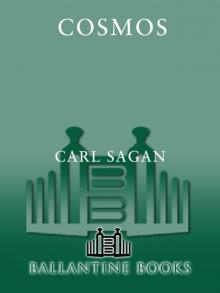 Cosmos
Cosmos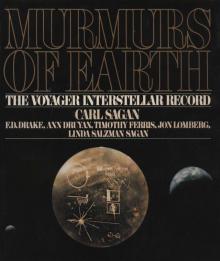 Murmurs of Earth
Murmurs of Earth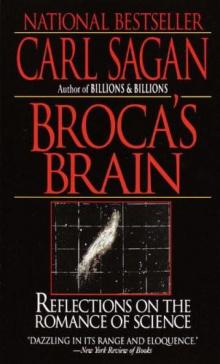 Broca's Brain
Broca's Brain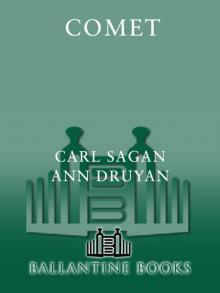 Comet
Comet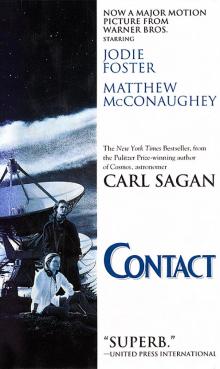 Contact
Contact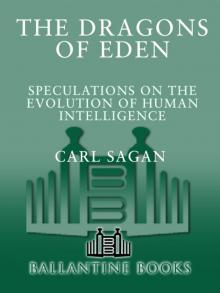 Dragons of Eden
Dragons of Eden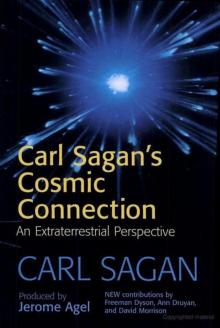 Cosmic Connection
Cosmic Connection Shadows of Forgotten Ancestors
Shadows of Forgotten Ancestors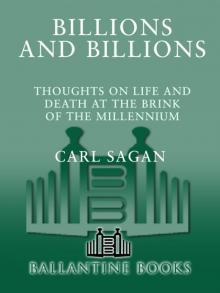 Billions & Billions
Billions & Billions Comet, Revised
Comet, Revised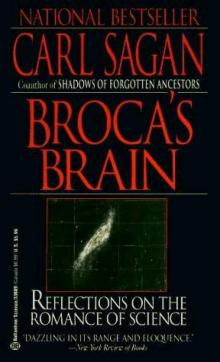 Broca's Brain: The Romance of Science
Broca's Brain: The Romance of Science The Varieties of Scientific Experience: A Personal View of the Search for God
The Varieties of Scientific Experience: A Personal View of the Search for God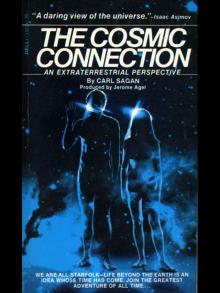 The Cosmic Connection
The Cosmic Connection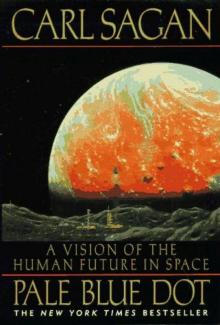 Pale Blue Dot: A Vision of the Human Future in Space
Pale Blue Dot: A Vision of the Human Future in Space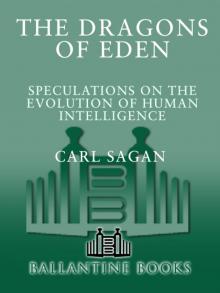 The Dragons of Eden
The Dragons of Eden